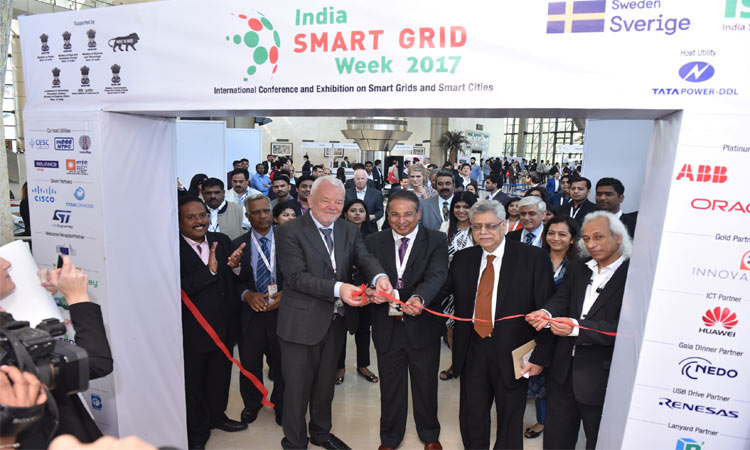
3rd Edition of International Conference and Exhibition ‘India Smart Grid Week 2017’ Concluded Successfully

The four day long International Conference and Exhibition ‘India Smart Grid Week 2017’ concluded successfully and received great response from the delegates, exhibitors and visitors. More than 200 internationally acclaimed experts in the field of energy, policymakers from the government and leaders from 50 countries converged together during the event to discuss on how to leverage the emerging technologies to provide reliable power and help in resolving critical gaps in electricity delivery across the country.
To meet the continuously rising energy requirement of the country and to supply 24×7 reliable power was the main theme of India Smart Grid Week 2017. This year the event had over 50 exhibitors and over 2000 trade visitors. As part of ISGW 2017 four bilateral workshops on smart grid technology cooperation’s were organized: Canada – India Smart Grid Workshop, European Union – India Smart Grid Workshop, Sweden – India Smart Grid Workshop and US – India Smart Grid Workshop. The event was supported by Ministries of Power, New & Renewable Energy, Science & Technology, Environment, Forest and Climate Change, NITI Aayog, Make in India and several other government institutions and international agencies. Other important topics discussed during the event were on advanced solutions for grid modernization, FDI in smart infrastructure, e-mobility and future of transportation and renewable energy integration.
ISGW 2017 began with a welcome address by Reji kumar Pillai, President, ISGF followed by the special addresses by the prominent guests that included Richard Schomberg, EDF & IEC and Chairman of ISGW Program Committee; N.Venu, ABB; Kavita Mohammed, Intel India; Francois Vazille, Vice President, Oracle Utilities Asia Pacific and Japan; Debashis Banerjee, CEO, Reliance Energy, Mumbai; Ajay Mathur, Director General, TERI; H.E.Harald Sandberg, Ambassador of Sweden; Henry Steingass, Regional Director for South and Southeast Asia, USTDA; Makoto Watanabe, Executive Director, NEDO, Japan; H.E. Tomasz Koslowsky, Ambassador of European Commission and Mr. Praveer Sinha, CEO and MD, Tata Power – DDL. Mr. PK Pujari, Secretary, Ministry of Power inaugurated ISGW 2017.
Another highlight of ISGW 2017 was the launch of Smart H2O – a free mobile app available for all citizens of India. This app allows the citizens to report water waste and be a part of the bigger revolutions like Digital India, Smart Cities Vision, National Water Mission and Water Conservation. Smart H2O is powered by Smart Utility Systems (SUS), an ISGF member providing of smart energy and water cloud platforms.
Launching the Smart H2O app, Mr. Reji Kumar Pillai, President, India Smart Grid Forum said, “This is a great initiative and we are sure that this app will help in improving water use efficiency, minimize wastage and save water”.
Although India operates one of the largest electricity grids in the world with 310 GW generation capacity, over 250 million people are not connected to the grid and several parts of the country experience frequent power cuts. India’s per capita consumption of electricity which is one-third of world average is expected to increase as the economic development of the country progresses. As the quality of life will witness ascendancy, people’s demands will rise on a parallel note. With an ever-increasing need of energy and challenges such as need to control power theft and transmission losses, India has launched ambitious missions to establish smart grids and smart cities. Making energy supplies efficient is key to power the country’s industries and growth but the power infrastructure in India faces multiple challenges. While millions of Indians still have no or limited access to electricity, power outages and poor supply quality are other major challenges hampering the country’s economic progress.
Smart Grid is an evolving set of technologies to transform the electricity grid in to a more intelligent and reliable grid with integrated control systems that helps electric utilities manage supply and demand effectively in real time and avoid power cuts, ensure power quality that will eliminate the need for voltage stabilizers and inverters and also help customers save money by shifting some of their electricity usage like water pumping, washing machines etc to run during non-peak hours at reduced rates.
